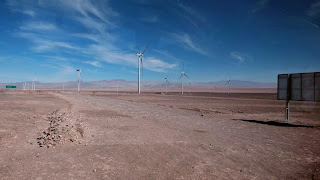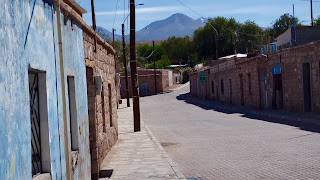In 1965 there was a huge earthquake in Chile - one of the largest ever recorded - and a large amount of land sunk a couple of metres. You can see this by the trees that are growing underwater.
The whole area started to grow reeds and it became a magnet for waterbirds - so much that it is one of the RAMSAR areas (designated bird reserves of international importance) of the world. Here there are many birds, including black and white swans, black faced gulls, herons and cormorants.
It is a beautiful area.
With gardens.
And sea lions
There is also the only Oberon class submarine that is still floating used as a museum.
We then went to a concert.
Sunday, 28 October 2018
Friday, 26 October 2018
Lakes
The Lakes district of Chile is an enormous contrast to the Atacama desert. We have gone from a place that receives almost no rain to one that receives three metres a year! Chile’s most active volcano is located here, and there are many places where you can see it, completely covered in snow.
We visited the private gardens of the Hotel Antumalal.
Then the private garden of the Gutierrez family near Villarrica.
We have decent internet here, so I will try to get completely up to date with my blog posts. Editing the pictures down to a reasonable number, copying them to google and then putting them all into the blog posts will take the most time! Hopefully I can get it done before we go to the next hotel.
We visited the private gardens of the Hotel Antumalal.
Then the private garden of the Gutierrez family near Villarrica.
We have decent internet here, so I will try to get completely up to date with my blog posts. Editing the pictures down to a reasonable number, copying them to google and then putting them all into the blog posts will take the most time! Hopefully I can get it done before we go to the next hotel.
Old things
We made our way back to Calama where the airport is located.
We stopped at Parque para la Preservacion de la Memoria Historica - the memorial to the people who were murdered and buried in mass graves during the Pinochet regime. The father of our bus driver was one of those whose body has never been found after he was taken and tortured.
It's in the middle of a huge wind farm which stretches for kilometers along the desert.
The Jerez Canyon is the location of the longest river in Chile. Dotted along it are a series of communities, which have been there for a very long time.
Firstly we visited Chiu Chiu - this is the town square.
Chiu Chiu is home of the oldest church in Chile. The conquistadors came through here on their way to Santiago.
The ceiling and gates are made from cactus wood, as have been a number of other places I’ve seen in the desert.
The same farming techniques are used here as elsewhere in the desert.
Then we visited Pukara de Lasana, a fortified village built at least 800 years ago, consisting of over 150 buildings.
We could see the same fields and water channels preserved here that were in the other Atacama villages.
When we took off, I took photos of Calama.
Oases and Salt Lakes
There are still many communities in the Atacama desert that practice their traditional farming techniques from pre-Colombian times in oases. We visited one where there is a river running through a canyon (I think the water appears and disappears underground on either side of the village). They have an extensive network of small channels that they use to flood irrigate their fields in rotation every 15 to 20 days.
The village is very close to the Andes, and they visit the lake at the top of the local volcano once a year to give thanks for the clear fresh water.
All the houses are built together and they appear very parched as the streets are all brick and the houses are right on the street.
We walked through the desert around the village and the fields and noticed the poplars and other large trees they grow. The desert stops at a wall, or one side of the river bank, and the plants are prolific inches away.
Each field is surrounded by brush walls and separated from the paths with gates but the tree branches cover most of the paths making them a lot cooler.
They use many of the crops we are used to - persimmons and pears formed the top story in the garden we were shown, with apricots forming a lower story and herbs like mint, parsley, and leafy green vegetables forming the ground cover.
We left that village and drove to another at the foot of another mountain of the Andes. This village was in a wetter area, where some grass grows, but without an oasis. The farms were dotted around, and each field was in a valley where the water was channeled to make a wetter area.
After we left the villages, we went back down into the desert to the salt lakes where pink flamingos live.
We stopped To see the museum with a collection of pre-Colombian artifacts including very old textiles. Although the collection was very small, it was stunning.
Subscribe to:
Comments (Atom)





















































